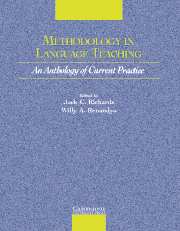Book contents
- Frontmatter
- Contents
- Acknowledgments
- Introduction
- Section I Approaches to Teaching
- Section 2 Lesson Planning and Classroom Management
- Section 3 Classroom Dynamics
- Section 4 Syllabus Design and Instructional Materials
- Section 5 Task and Project Work
- Section 6 Learning Strategies
- Section 7 Teaching Grammar
- Section 8 Teaching Pronunciation
- Section 9 Teaching Speaking
- Section 10 Teaching Listening
- Section 11 Teaching Vocabulary
- Section 12 Teaching Reading
- Section 13 Teaching Writing
- Section 14 Assessment
- Section 15 Technologies in the Classroom
- Section 16 Professional Development
- Credits
- Author Index
- Subject Index
Section 10 - Teaching Listening
Published online by Cambridge University Press: 10 November 2010
- Frontmatter
- Contents
- Acknowledgments
- Introduction
- Section I Approaches to Teaching
- Section 2 Lesson Planning and Classroom Management
- Section 3 Classroom Dynamics
- Section 4 Syllabus Design and Instructional Materials
- Section 5 Task and Project Work
- Section 6 Learning Strategies
- Section 7 Teaching Grammar
- Section 8 Teaching Pronunciation
- Section 9 Teaching Speaking
- Section 10 Teaching Listening
- Section 11 Teaching Vocabulary
- Section 12 Teaching Reading
- Section 13 Teaching Writing
- Section 14 Assessment
- Section 15 Technologies in the Classroom
- Section 16 Professional Development
- Credits
- Author Index
- Subject Index
Summary
INTRODUCTION
For many years, listening skills did not receive priority in language teaching. Teaching methods emphasized productive skills, and the relationship between receptive and productive skills was poorly understood. Until recently, the nature of listening in a second language was ignored by applied linguists, and it was often assumed that listening skills could be acquired through exposure but not really taught. This position has been replaced by an active interest in the role of listening comprehension in second language acquisition, by the development of powerful theories of the nature of language comprehension, and by the inclusion of carefully developed listening courses in many ESL programs. Some applied linguists go so far as to argue that listening comprehension is at the core of second language acquisition and therefore demands a much greater prominence in language teaching. The papers in this section explore the nature of second language listening and principles for the design of teaching activities and classroom materials.
In the first paper, Nunan points out that in order to develop appropriate approaches to teaching listening skills, it is first necessary to understand the nature of listening. Two models of listening can be identified: the bottom-up and the top-down processing models. The bottom-up processing holds that listening is a linear, data-driven process. Comprehension occurs to the extent that the listener is successful in decoding the spoken text. The top-down model of listening, by contrast, involves the listener in actively constructing meaning based on expectations, inferences, intentions, and other relevant prior knowledge.
- Type
- Chapter
- Information
- Methodology in Language TeachingAn Anthology of Current Practice, pp. 235 - 237Publisher: Cambridge University PressPrint publication year: 2002
- 1
- Cited by

